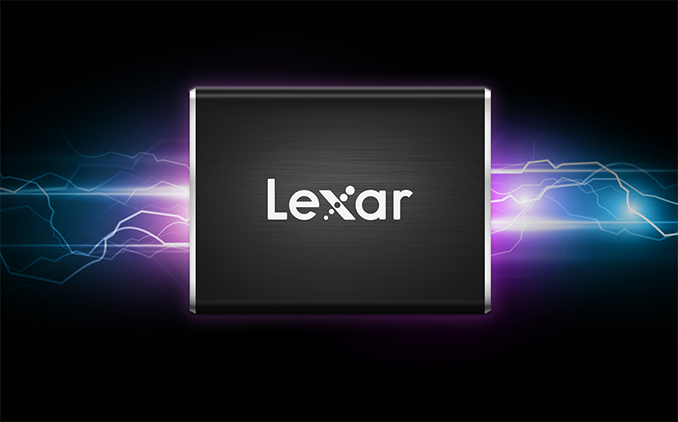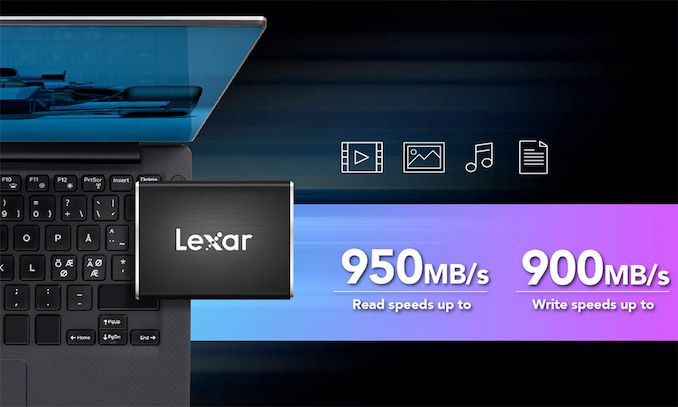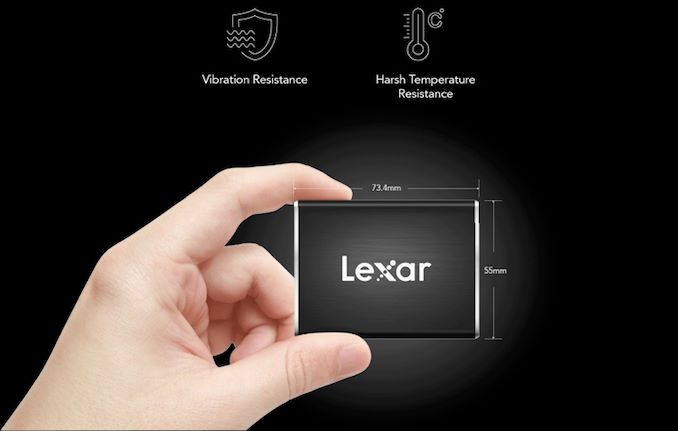Lexar SL100 Pro Portable USB 3.1 Gen 2 External SSDs: Fast and Up to 1 TB
by Anton Shilov on April 5, 2019 2:00 PM EST
Lexar this week introduced its first external SSDs featuring a USB 3.1 Gen 2 Type-C interface. The SL100 Pro drives are lightweight, miniature, and offer a read speed of up to 950 MB/s, maxing out capabilities of the interface.
Lexar’s Professional SL100 Pro Portable SSDs will be available in 250 GB (LSL100P-250RB), 500 GB (LSL100P-500RB), and 1 TB (LSL100P-1TRB) configurations, targeting customers with different requirements. The drives are set to offer up to 950 MB/s sequential read speed as well as up to 900 MB/s sequential write speed, but Lexar does not specify whether all the SSDs in the lineup feature such speeds, or only the 1 TB version does. The drives are bus powered and feature a USB Type-C connector, yet the manufacturer will ship them both with a USB-C to USB-C as well as a USB-C to USB-A cable.
Measuring 73.4×55×10.8 mm and weighing approximately 70.5 grams, the SL100 Pro Portable SSDs are as sleek as many high-capacity USB flash drives, yet their performance is considerably higher. Meanwhile, the SSDs come in an aluminum chassis that can withstand vibrations and drops. They are certified to to work in a temperature range between 0° and 70°C. Lexar will also supply DataVault Lite program with the Professional SL100 Pro Portable SSDs to encrypt files using AES-256 for maximum security.
Lexar already lists its SL100 Pro external SSDs on its website, so expect them to become available shortly. Prices are unknown, but we do know that the drives are covered by a three-year warranty.
Related Reading
- SanDisk's Mainstream Extreme PRO Portable SSD Goes NVMe
- Panasonic Announces Its First Thunderbolt 3 SSDs
- MyDigitalSSD Pocket Vault Express (PVX) Thunderbolt 3 1TB SSD Capsule Review
- ADATA Introduces SC660H and SV620H External SSDs with 3D TLC NAND
- ADATA Launches the SD700 External SSD: Dust, Water and Shock Resistant (with 3D NAND)
- ADATA SD700 512GB External SSD Capsule Review
- Longsys Acquires Lexar Brand from Micron
Source: Lexar (via Hermitage Akihabara)













3 Comments
View All Comments
abufrejoval - Sunday, April 7, 2019 - link
I’ve been playing around with the Jetson Nano you made me buy. I am looking either for a microSD card, that can actually do IOPS (seems so unlikely), or a USB stick, that actually delivers something like Intel Postville SDD performance, which is all the Nano will take anyway (nothing on those USB3 ports will go faster than about 140MB/s.There is all kinds of crazy bandwidth available on USB and microSD, but I want IOPS, a SCSI or UASP command set with nice queues, trim/discard. I doubt that can be done on microSD, where capacity rules that little space, but on USB sticks or perhaps even better yet, USB2SATA that *should* be possible, right?
Could you guys have a look, do a report, or—in case I just missed it—provide a pointer?
Took a 64GB SanDisk Extreme V30/A1/UHS-1 from a smartphone that wasn’t paying attention and that does work kind-of. You have to enable swapping rather quickly when you run Cinnamon on a 4k screen and anything with a bit of I/O like compile jobs, quickly ties the Nano into a knot idling on wait-for-io. An ASmedia 2105 was a bit disappointing, because even if it was recognized as a SCSI device, it wouldn’t pass through trim/discard: Never a good thing on SSD and a real bummer, because the SanDisk microSD *will* trim.
DougDolde - Monday, April 8, 2019 - link
So can you plug one into a Thunderbolt port with a USB-C cable?star-affinity - Tuesday, April 9, 2019 - link
If one has a computer with Thunderbolt 3 this in combination with a NVMe drive of choice sounds like an interesting alternative (Thunderbolt 3 M.2 NVMe Metal External case 40 Gbps): https://i-tec.cz/en/produkt/tb3mysafem2-2/Should break away from the 10 Gbit/s limit of USB 3.1 Gen 2 which sure hampers the speed of a NVMe drive.